As an annual game event, the status of GDC (Game Developers Conference) is very important. In particular for the VR industry - a company CEO once confessed with the author: "CES can not go, but the GDC must go." In 2017, GDC will still hold VRDC, covering all VR / AR-related entertainment projects.
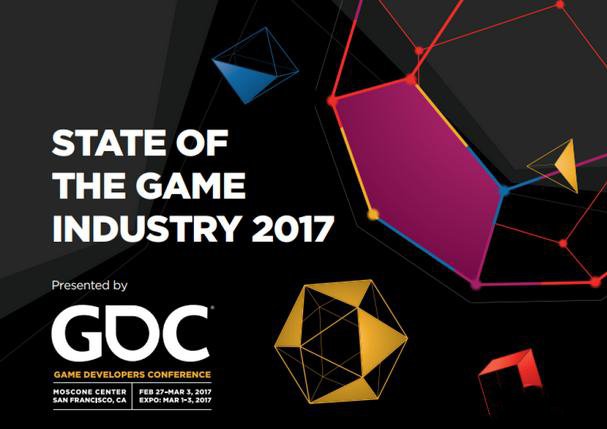
GDC has surveyed more than 4,500 game developers who have participated in the past three years and hopes to have a glimpse of the entire picture of the game industry and clarify the new trends in the industry. The report covers team size, VR, e-sports, platform selection, financing related, and more.
The report mainly reveals trends, including HTC Vive becoming the most popular VR/AR platform for developers, gradually shrinking crowdfunding success rate, and e-sports as the rise of long-term sustainable business.
The following is the compilation of the full text of GDC's annual report:
About the respondent
Most of the respondents were from North America or Europe, 67% from North America, and 22% from Europe. Asia-Pacific region is 8%, 3% from South America, only 0.3% came from Africa.
Among them, 20% were female and 78% were male. The rest answered "non-male and non-female" or did not want to answer. Last year there were 79% of men and 18% of women.
Most developers have been playing games for 3-6 years, 37% of respondents are in this section, 17% of developers have spent 7-10 years, and developers have just developed 1-2 years. 13%. Last year, the ratio of these three blocks was 35/17/17.
VR development doubled compared to last year
Although several high-end VR helmets were on the market in 2016, most developers are still developing games on PCs and mobile devices. Regarding “on which platform the previous game was releasedâ€, 45% of the respondents stated that on PC/Mac computers, 35% are called smart phones or tablets. 19% said it was PS4/Pro, 15% said it was Xbox One, and 13% said that the new tour was released on the VR helmet. This figure was only 6% last year.

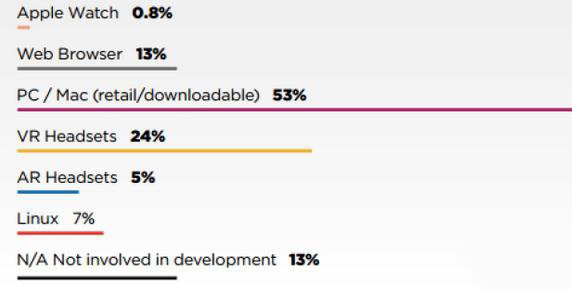
(From top to bottom: Xbox 360, Xbox One/Planet, PS3, PS4/Pro, PSP, PSV, Nintendo Wii, Wii U, 3DS, DS, Switch, Phone/Tablet, Android Box, Apple TV, Apple Watch, Page Tour, Computer/Mac, VR Helmet, AR Helmet, Linux Platform, No Development)
Which platform is currently developing the game?
As for which platforms people are currently focusing on, the conclusion is similar: 53% of respondents said that they are currently developing PC/Mac games, and 38% are called smartphones/tablets. 27% are talking about PS4/4 Pro, 24% are VR helmets, and 22% are Xbox One. This ranking is basically consistent with last year.
However, there has been a big change: the number of developers who are developing VR games has risen sharply, more than those who developed games for Xbox One. Last year, 23% of developers claimed to be developing games for Xbox One, while VR helmets were 16%.
Looking further ahead, the distribution of interest is continuing: 52% of the respondents planned to publish the next game on the PC/Mac, and 34% said it was a smartphone/tablet. 29% are PS4/4 Pro, 23% are VR helmets, and 22% are said to be released on Xbox One or its next-generation host "Scorpio".
Nintendo's Switch consoles are also expected to be available this year, with 3% saying they are developing games for Switch and 5% wanting the next games to go to Switch.
Android finally exceeds iOS on mobile development
In the previous GDC industry survey, the most popular mobile platform for developers was iOS, and about 54% of respondents said they are developing games for Android, and 51% for iOS. Last year, 56% of respondents said they were iOS, 55% of Android, and 40% said they currently have not developed games for any mobile platform.

(From top to bottom: Android, iOS, PS Mobile (including PSP, PSV, etc.), Windows Phone, None, Other)
Does the PS4 Pro "upgrade" host harm the gaming industry?
Most game developers expressed uncertainty about the game console's attitude toward intermediate iterations of the upgraded game console (PS4 Pro/Microsoft): 41% of the respondents did not decide, and 36% said they were neutral. Another 18% believe this is positive for the industry, and only 5% consider it negative. A respondent said: "Hosts do need to rejuvenate because they have lower parameters than computers. Although I don't want the market to be fragmented, I don't want to have a new host every year, because it will seriously hurt. Host market."
However, another person thinks: "The advantage of the host is that the platform is fixed and the parameters are single. This kind of 'upgrade' will break this advantage. Developers now have to develop two games, one for a more powerful platform, or Release a compressed version on a low-performance platform."
Half of people have confidence in Nintendo Switch
For Nintendo's new host Switch, developers feel better, this host can switch between handheld / host. When asked if this console could outsell Nintendo's Wii U (approximately 13 million installed worldwide), 50% think it will, 14% will not, and 37% will not know it.
Switch's ability to switch between the host and the handheld is its core selling point, but the respondent is not sure whether the public can accept it. 48% think it will, but it will not change the impact of the industry, 19% also believe that, and that Switch is the right product for the right time. Another 11% think that people will not be interested in the core selling point of Switch, 23% said they do not know.
HTC Vive Exceeds Oculus Rift and Becomes the Most Popular VR/AR Platform for Developers
61% of the respondents currently do not develop games on VR helmets, but among those who are developing, HTC Vive exceeds other platforms. 24% said Vive, 23% said Oculus Rift and 13% said PSVR.
This is a significant change from last year when only 19% said that games were developed on the Oculus Rift, and HTC Vive and PSVR were 6%.
In 2016, these helmets were on the market. GDC's industry report also asked developers for the first time. The issue of the last VR game was released on the platform. Most (75%) said they had not yet released VR games, and 11% said that the previous game was on the Oculus Rift. 10% are HTC Vive, and 6% are Samsung Gear VR.
So which VR/AR platform will be released for the next game (ie the next game under development)? HTC Vive tops the list with 40%, Oculus Rift is 37%, and 26% is PSVR.
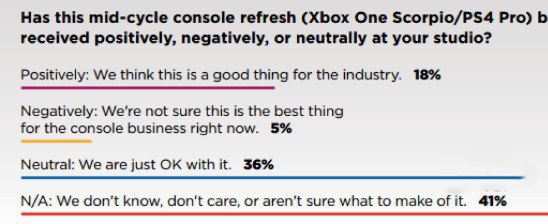
11% developing exclusive VR games
One-tenth of game developers are developing exclusive VR/AR games, of course, Vive still dominates. Recently, the topic of VR game platform exclusive (limited time, etc.) is hot, so GDC also asked whether the next VR/AR game of the interviewee is exclusive to a certain platform.
Half of the respondents said they did not involve VR/AR game development, and 39% denied that their next VR/AR game would not be monopolized on a single platform. 11% of the respondents admitted they would monopolize.
Of the respondents who acknowledged the exclusive use of the next game, 33% claimed to be developing exclusive games for HTC Vive, making it the most popular exclusive VR platform, with 24% being Oculus Rift and 15% being PSVR. Exclusive.
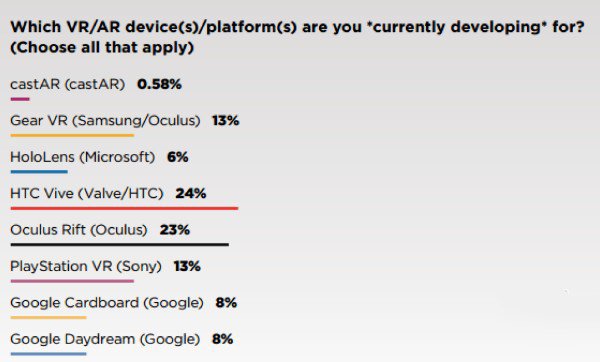
Vive outperforms other VR/AR platforms in developer interest. When asked about the VR/AR platform that developers are most interested in, 45% are Vive, 30% are Oculus Rift, and 29% are PSVR. Microsoft's HoloLens ranked fourth with 24%.
Compared to last year's data, the trend of developers shifting from Rift to Vive is once again: 40% of developers claimed that Oculus Rift was the most interested in VR/AR platform last year; 26% said it was HTC Vive, and 26% Says PSVR, 25% says HoloLens.
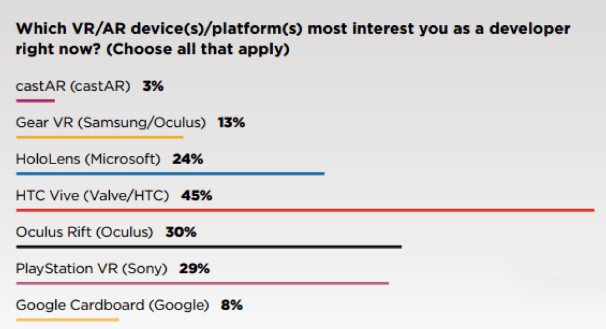
Which VR/AR development prospects are better?
Most developers believe that VR/AR is a long-term sustainable business. This conclusion is similar to last year. 75% give a positive reply, 25% think it is not. Same as last year.
A respondent wrote: “Focus on improving heads-up capabilities, liberating users, and enhancing valuable experiences give VR/AR opportunities for continued growth.†And another wrote: “At present, the price of hardware Still too expensive, the software is only developed because of the funds provided by the first party. Once the funds are dried up, there is no big enough base."
Most developers think that mobile VR/AR—especially AR is the future. When asked "what would be the mainstream immersive technology for the next five years compared to the VR/AR of the PC/host and the mobile," 33% of the respondents said they were mobile. 31% think it will be a PC and a host, and 17% think that both will be equally popular. 8% said that both are not important, and 12% do not know.
In the question of “Which VR and AR will be the mainstream immersive technology in the next 20 years,†43% of the respondents answered AR, and 21% thought that the two are equally popular. 19% predicted that VR is more popular and 12% said it is not. As you know, 5% think that in the next 20 years, both are not important.
The situation of motion sickness seems to have improved
Most developers have expressed discomfort in VR, but only less than 10% claim to always feel uncomfortable in VR. 9% said that in all VR experiences, discomfort or motion sickness is caused, 17% said they never felt unwell, 43% said they would feel in some VR experiences, and 31% said they would rarely This happens.
Issuers only participate in about a quarter of respondents’ projects
Most of the respondents did not cooperate with the issuer. Asked whether or not the previous project had cooperated with the issuer, 54% had denied it, 25% had acknowledged that 21% thought the problem was not appropriate, either because their position could not cooperate with the issuer or that they were issuers themselves. This result is also similar to last year. Last year's figures were 56% denied, and 23% acknowledged.
34% of the respondents said that they plan to cooperate with the issuer on the next project, and 44% still do not have this plan - this is also the same as last year, which means that most of the game industry is not a traditional developer/distribution. Party relationship model.
Most game development is still self-purse
There are many ways to fund game development nowadays, but it seems that the most popular choice is still to pay for itself - either the company's funds or its own funds.
In terms of funding sources, 55% of the respondents said that they were from the company's existing funds, 29% were personal savings, and 15% were external issuers. The next most popular answer is neither crowdfunding nor venture capital, but the "other" (15%) with a wide coverage. In fact, it is the same as last year's result: Last year, the same 55% of the respondents answered that they were company funds, 34% were out of pocket, and 15% said they were external issuers.
Lower interest in crowdfunding
When discussing related experience with crowdfunding, most of the respondents (46%) said that they are not interested in crowdfunding. 24% said that they had never tried crowdfunding but they plan to try it recently. 15% said they had developed crowdfunding projects. Another 4% said that they had tried crowdfunding but did not reach the goal. This is probably the same as last year's result, but there is a slight decline. Last year, only 40% of people were not interested in crowdfunding. 29% of people who had never tried crowdfunding but had planned to try it recently had 15% said they had developed crowdfunding projects.
Digital Store Home Promotion is still considered to be the most effective means to promote the game
Promoting the game's preferred means, the promotion of the platform store's home page is still the preferred location, and the anchor of the Twitch live broadcast platform is at the bottom. Most respondents believe that the most effective way to promote the game is the promotion of the platform's digital storefront (such as Steam and PlayStation stores, etc.), and 19% of people listed it as the first name. The Twitch anchor is the last, and only 3% of developers claim that their last game received the most attention because of this approach.
This is the same as last year's survey, but most developers don't score in one way. Maybe most of them didn't try every way to promote the game. The following is the ranking of promotion tools used by developers from the top to the bottom:
However, the Twitch anchor is also the most neglected option for investigators. 45% of respondents chose “no†for this, which means that fewer developers than others have used Twitch to promote or even succeed. Same as last year.
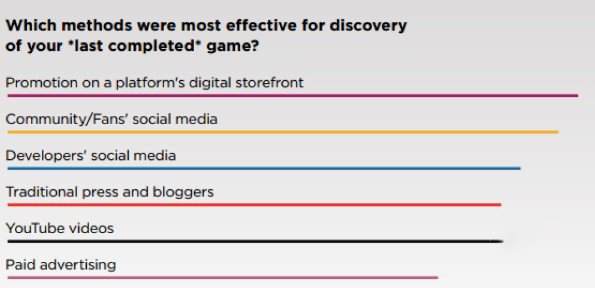
(From top to bottom: Digital Store Home Promotion, Community/Fans Social Media, Developer Social Media, Traditional Media & Blog, Youtube Video, Paid Advertising, Twitch Anchor)
The vast majority believe that e-sports will be a long-term, sustainable business
90% of respondents believe that e-sports (professional-level competitive games) is a long-term, sustainable business. Compared with 88% last year, there is a certain increase.
One respondent wrote: “As long as there are enough people to support it, it will work well. We can see that over the years, interest in e-sports has continued to grow. Acceptance of social games It is also being promoted, and one day it may develop something like football."
Another said: "After becoming an adult with a large generation of electric players, the game will acquire a status similar to that of traditional sports. It will no longer be the preference of otaku but will be recognized as part of the mainstream society and will continue. .
22Mm Metal Switches
22Mm Metal Switches is a larger size in the Metal Switches serious. It is designed vary from people and regions and the design of larger operation button face is for increasing the convenience and comfort when operating.
In order to create more function and save more space for this , Waterproof Metal Switch, we adopt single and dual control design, so our one switch could have multiple purposes. This Stainless Steel Switch are widely used in human interface panel, it has P67 dust-proof and waterproof function, IK10 stainless steel material damage resistance level, advanced mechanical life.

In addition, in order to meet customer requirements, our larger Anti Vandal Switches has passed the EU green environmental protection RoHS certification, the US UL testing certification, IP67 certification and TUV certification.
Moreover, customers can choose the metal button with LED light indication according to their own product requirements. The LED lamp beads are all from international brand suppliers to ensure the high life of LED lamp beads and the long-term work without discoloration effect.
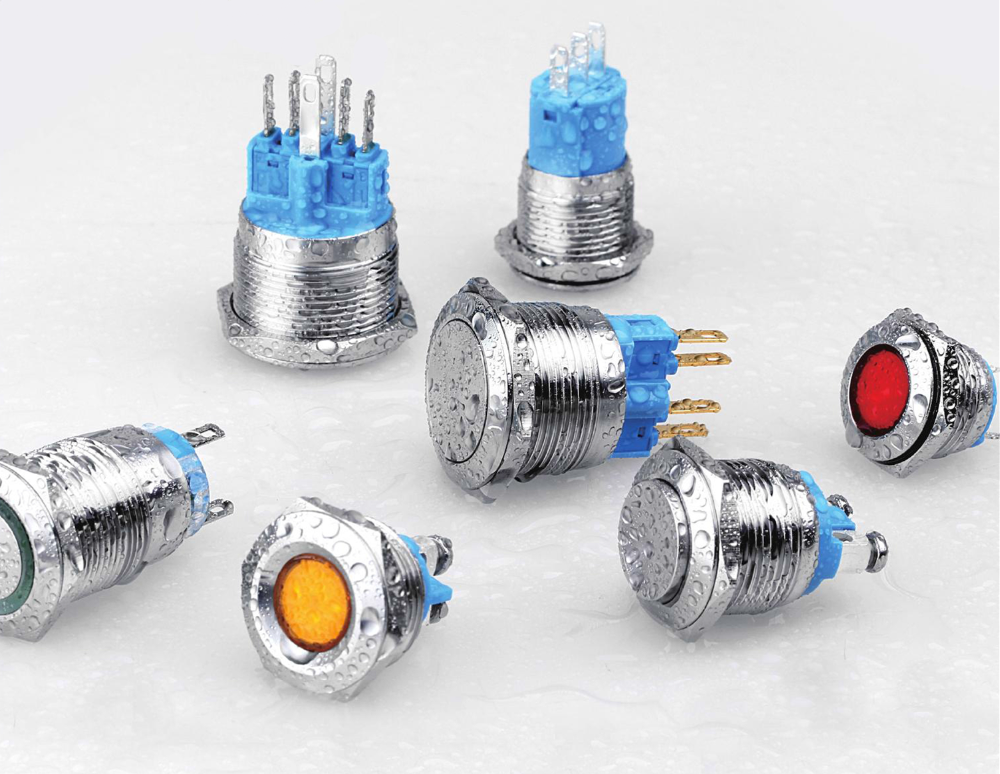
22Mm Metal Switches,22Mm Waterproof Metal Switch,22Mm Stainless Steel Switch,22Mm Metal Flush Push Button Switch
YESWITCH ELECTRONICS CO., LTD. , https://www.yeswitches.com